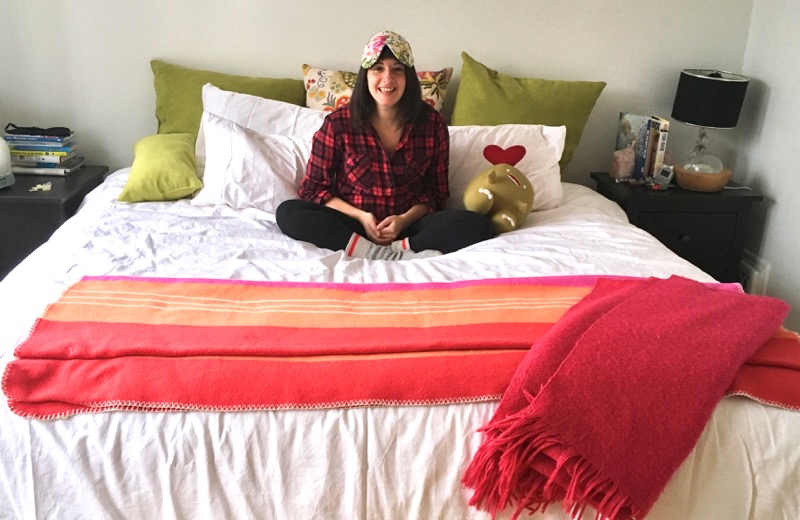

We spend one-third of our lives sleeping. You know what this means, right? This means we spend more time between the sheets and laying on our mattress than we do in any single pair of jeans, sweats, sneakers, hoodies, or party dresses. More than we spend lying on the couch, at work or driving in our cars.
And yet the way we spend and value quality when it comes to beds and bedding doesn’t always reflect this. Too often the bed and our linens are an area where we wait for sales, or we put these items on the back burner because it’s not something anyone else sees or experiences.
What you choose to sleep on and in could be one of the most critical decisions you can make. And the best part is, you only need to make this decision a few times throughout your lifetime!
It’s therefore critically important to create a healthful environment that helps us sleep better. Of course, this also includes what we eat throughout the day, the temperature of our bedroom, the mobile devices that surround us, and what we choose to sleep on – meaning our mattress and our bedding. In other words, if we’re going to be spending a third of our lives in contact with the sheets (especially when we’re naked!), choosing top-quality bedding is definitely the way to go.
Conventional bedding options are often loaded with chemicals that get super cozy with our skin and that’s why as part of any healthy lifestyle, the natural bedding we sleep on is going to play a role in our overall health.
The goods news? This is an easier problem to address than your clothing.
Given that my bed is actually my most favourite place to be (oh introverted me), when we got our new bed in 2016, I spent months researching every aspect to create the most perfect womb in the world!
(If you’re interested in learning about whole-home health, discover more about How I Created a Healthy Home here.)

One of the most popular bedding fabrics is cotton. I love it. It’s a natural fiber, it’s crisp and fresh feeling, it breathes and it washes and dries easily. Unfortunately, cotton is one of the dirtiest crops in the world because it’s so heavily sprayed with pesticides.
Unfortunately, chemicals and pesticides don’t just disappear once they hit the shelves of our favourite department store or we toss them in the washing machine – we are exposed to them as we sleep or relax in the bedroom.
The fabrics used in conventional bedding, both linens made of natural fibers like cotton or linen and polyester options, can be treated with extra plastics, harmful dyes and pigments, or additional chemicals to make them stain-resistant, water-resistant, static-resistant, or fire-resistant.
One study of Wisconsin households tested exposure levels of one flame retardant, polybrominated diphenyl ethers (PBDEs), that are commonly used in a variety of products such as bedding and upholstery. Researchers found PBDEs in vacuum cleaner dust, blood serum samples, and in the air.
To clarify, these chemicals don’t stay confined within the weaves of the fabrics – we not only inhale them as we sleep, but they also spread throughout our homes and when we wash them, they have the potential to react with the chemicals in the municipal water to create harmful byproducts.
Our sheets can actually be quite gross – and I don’t mean gross like your children away at college who only wash them once every solar eclipse. Dust mites that live in our sheets can be highly allergenic and contribute to asthma symptoms as well. These little critters absolutely love our carpets, mattresses, and beds.
In addition, our bedding can also accumulate bacteria, pollen, animal dander, human sweat and other secretions, and fungi. Delicious!
One study of pillows showed the average pillow has between 4 and 16 different species of fungi. And speaking of pillows, you don’t have to be a germaphobe to be totally grossed out by the estimate that 1/3 of our pillow weight is actually dust-mites, dead skin and other critters and bacteria (which is why whenever possible I travel with my own! Would rather it be my own dead skin!).
While many dust mites and allergens can be greatly reduced by washing our bedding on a regular basis, be mindful of what you’re using to clean your sheets. Common household cleaners like laundry detergent and dryer sheets have an array of volatile compounds that are detrimental to our health. Check out some natural home cleaning options here.
The great news here is that natural fibers like organic cotton and wool are naturally resistant to mites, fungi and bacteria. Winning all around!
Bonus tip! You can also help reduce allergens in your bedroom by investing in a medical grade air purifier. The Jaspr Pro is the one I use and love (use code MTBREATHE at checkout to save big). 
The good news is that it’s easy to reduce your exposure to potentially harmful chemicals and toxins by choosing natural bedding for your bedroom.
These are a few linen brands to get you started on your search.
If you’re in the market for a new mattress, we have bought several mattresses from Sunshine Mattress Co. Use the coupon code MEGHAN5 for 5% off mattresses and MEGHAN10 for 10% off pillows and bedding.
Let your bed be a place to rest and rejuvenate. You don’t need to toss out what you have now, but when it’s time to update and upgrade, you now know where to start in your search.
In the meantime, start washing what you have in natural, chemical-free detergents and check out what your pillows are made of, and follow the recommended cleaning instructions. Both of those small steps are a great start!

The post Natural Bedding and Linens Guide for Truly Sweet Dreams appeared first on Meghan Telpner.